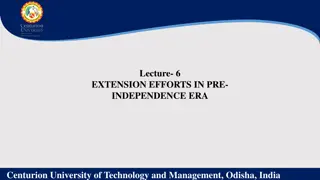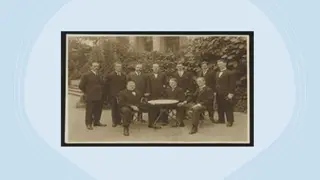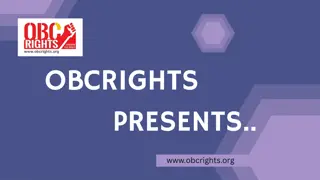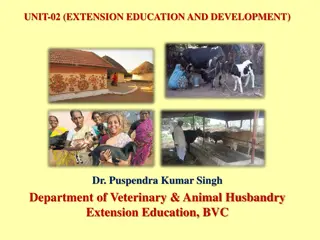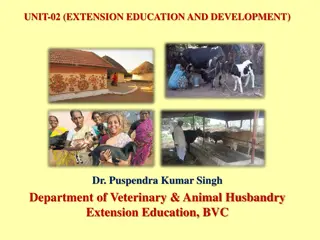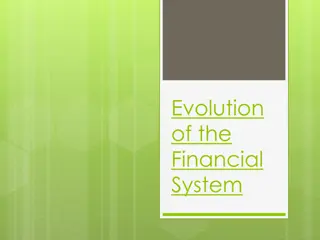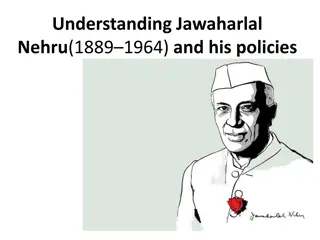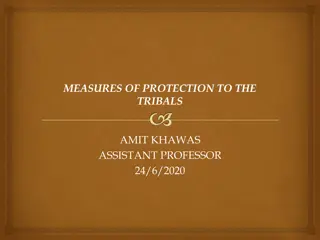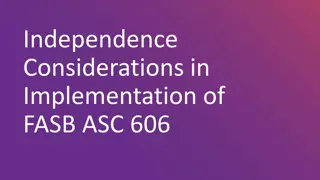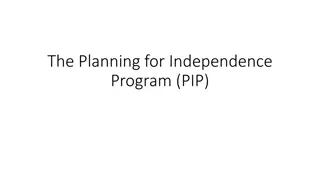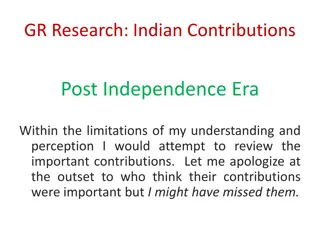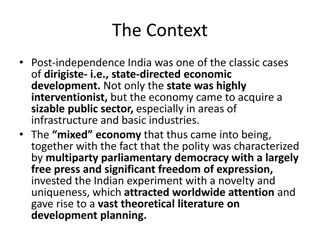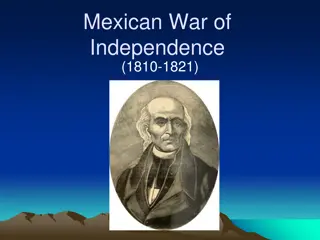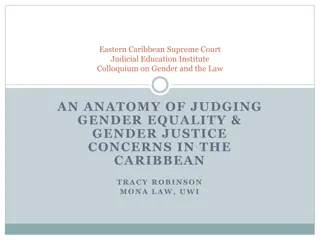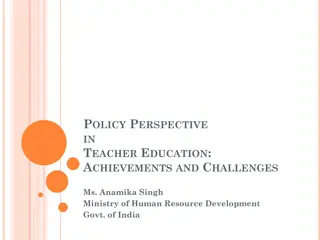Development of Education in India: Post-Independence Era Policies
This content discusses the development of education in India after independence, focusing on the National Education Policy of 1986 and the Draft National Policy on Education of 1979. It also emphasizes the critical analysis of policies and the need for effective implementation based on societal realities and ideologies.
Download Presentation

Please find below an Image/Link to download the presentation.
The content on the website is provided AS IS for your information and personal use only. It may not be sold, licensed, or shared on other websites without obtaining consent from the author.If you encounter any issues during the download, it is possible that the publisher has removed the file from their server.
You are allowed to download the files provided on this website for personal or commercial use, subject to the condition that they are used lawfully. All files are the property of their respective owners.
The content on the website is provided AS IS for your information and personal use only. It may not be sold, licensed, or shared on other websites without obtaining consent from the author.
E N D
Presentation Transcript
4thSemester Major (FYUGP) Subject: EDUCATION Course Name: DEVELOPMENT OF EDUCATION IN INDIA Unit-4: Development of Indian Education: the post-independence period National Education Policy 1986
National Policy on Education (1986): Critical Analysis
Policy: Meaning a set of ideas or a plan of what to do in particular situations agreed to officially by a group of people, a business organization, a government, or a political party. , Dictionary. An ideology in itself which gives a direction basically. that has been Cambridge English
How policies should be studied? Policies always have hidden agenda: look at it from a critical perspective.(Socially, Politically and Economically) Myth: Policies are always implementation is not proper/ineffective. If our policies are not reasonable, logical and sensible and do not match with the reality of the society we live in, not useful for the up gradation of society one aspires to become, then the implementation of such policies in an honest and rigorous manner would be of no benefit and vice versa. In a nutshell, the logic, principles and ideology behind policies is on one side and its implemantaion on another. Thus, there is a need to critically look into these two sides of a policy separately. perfect/good but the
DRAFT NATIONAL POLICY ON EDUCATION (1979) Another serious attempt , after Education Commision and NPE 1968, was made to formulate a comprehensive policy on education based on a national consensus when the Central Government brought out the draft of a new National Policy on Education in 1979 which envisaged to recast education at all levels so as to make the education process functional in relation to the felt needs and potentialities of the people. Highlights of the draft policy include Universal Elementary Education, which further included; Common School System with Neighbourhood School Plan Adult education Secondary education; vocational education Diversification and reduction of academic load, Three-language formula Medium of instruction Examination reform Community participation, Agriculture & Medical Education, Control of fee structure of Public Schools etc. It was intended to have a nationwide debate on the document before its eventual finalisation as a critical Policy Statement to charter the development of education for the next two decades i.e. upto the end of twentieth century. However, due to some political uncertainty during the period, the proposed policy could not take off.
The announced in 1986 after 1968 policy, to prepare India for the next century or 21stcentury needs and requirements. National Policy on Education (NPE) was The introduction of the policy makes it very humane and shows faith in changes, as per their requirement. It starts, Education has continued to evolve, diversify and extend its reach and coverage since the dawn of human history. Every country develops its system of education to express and promote its unique socio-cultural identity and also to meet the challenges of the times. There are moments in history when a new direction has to be given to an age- old process. That moment is today.(1.1)
Recommendations 1. NATIONAL SYSTEM OF EDUCATION Firstly, it should be noticed that the ideas of the national system of education evolved between 1906 when the Indian National Congress adopted its Resolution on national education and 1966 when the Education Commission submitted its report were conceived in very different social, economic and political contexts. It was further recommended by NPE 1968 after a great deal of controversial discussions uopn this concept among the members of parliament and others. In NPE 1986, the concept of National System of Education implies that, up to a given level, all students, irrespective of caste, creed, location or sex, have access to education of a comparable quality. Effective measures will be taken w.r.t.: Common School System: Post-independence the concept of common school system was recommended by Education Commission which used two expresions in this regard; the common school system of public education and the neighbourhood school which was an integral part of the former. Common Educational Structure: The 10+2+3 structure has now been accepted in all parts of the country. Regarding the further break-up of the first 10 years efforts will be made to move towards an elementary system comprising 5 years of primary education and 3 years of upper primary, followed by 2 years of High School.
National Curricular Framework: It contains a common core which will include the history of India's freedom movement, the constitutional obligations and other content essential to nurture national identity. These elements will cut across subject areas and will be designed to promote values such as India's common cultural heritage, egalitarianism, democracy and secularism, equality of the sexes, protection of the environment, removal of social barriers, observance of the small family norm and inculcation of the scientific temper. All educational programmes will be carried on in strict conformity with secular values. Equality of opportunity: To promote equality, it will be necessary to provide for equal opportunity to all not only in access, but also in the conditions for success. Minimum Levels of Learning: Minimum levels of learning will be laid down for each stage of education. Steps will also be taken to foster among students an understanding of the diverse cultural and social systems of the people living in different parts of the country. Besides the promotion of the link language, programmes will also be launched to increase substantially the translation of books from one language to another and to publish multi- lingual dictionaries and glossaries. Research and Development and Education in Science and Technology: special measures will be taken to establish network arrangements between different institutions in the country to pool their resources and participate in projects of national importance. Life-long Education through Open and Distance learning
Role of different institutions in giving shape to the national system of education; UGC, AICTE, NCERT, NIEPA, ICAR, IMC, and IISTE. A Meaningful Partnership between the Centre and the State: The Constitutional Amendment of 1976, which includes Education in the Concurrent List, was a far-reaching step whose implications--substantive, financial and administrative-- require a new sharing of responsibility between the Union Government and the States in respect of this vital area of national life. While the role and responsibility of the States in regard to education will remain essentially unchanged, the Union Government would accept a larger responsibility to reinforce the national and integrative character of education, to maintain quality and standards (including those of the teaching profession at all levels), to study and monitor the educational requirements of the country as a whole in regard to manpower for development, to cater to the needs of research and advanced study, to look after the international aspects of education, culture and Human Resource Development and, in general, to promote excellence at all levels of the educational pyramid throughout the country. Concurrency signifies a partnership which is at once meaningful and challenging; the National Policy will be oriented towards giving effect to it in letter and spirit. Education For Equality: The new Policy will lay special emphasis on the removal of disparities and to equalize educational opportunity by attending to the specific needs of those who have been denied equality so far. It included Education for Women's Equality, the Education of SCs amd STs, other educationally backward sections and areas, minorities, and handicapped.
Adult Education: Our ancient scriptures define education as that which liberates - i.e. provides the instruments for liberation from ignorance and oppression. In the modern world, it would naturally include the ability to read and write, since that is the main instrument of learning. Hence the crucial importance of adult education, including adult literacy. A vast programme of adult and continuing education will be implemented through various ways and channels, including- (a) establishment of centres in rural areas for continuing education; (b) workers' education through the employers, trade unions and concerned agencies of government; (C) post-secondary education institutions; (d) wider promotion of books, libraries and reading rooms; (e) use of radio, TV and films, as mass and group learning media; (f) creation of learners' groups and organisations; (g) programmes of distance learning; (h) organizing assistance in self-learning; and (i) organising need and interest based vocational training programmes.
REORGANISATION OF EDUCATION AT DIFFERENT STAGES Early Childhood Care and Education: Recognising the holistic nature of child development, viz., nutrition, health and social, mental, physical, moral and emotional development, Early Childhood Care and Education (ECCE) will receive high priority and be suitably integrated with the Integrated Child Development. Services programme, wherever possible. Day-care centres will be provided. Programmes of ECCE will be child-oriented, focussed around play and the individuality of the child. Formal methods and introduction of the 3 R's will be discouraged at this stage. The local community will be fully involved in these programmes. A full integration of child care and pre-primary education will be brought about, both as a reeder and a strengthening factor for primary education and for human resource development in general. In continuation of this stage, the School Health Programme will be strengthened. ELEMENTARY EDUCATION: will emphasise two aspects : .(i) universal enrolment and universal retention of children up to 14 years of age, and (ii) a substantial improvement in the quality of education. It further included: 1. Child centered education 2. School facilities: Provision will be made for minimum essential facilities to all primary schools, including at least two reasonably large rooms that are usable in all weather, and the necessary toys, blackboards, maps, charts, and other learning material. At least two teachers, one of whom a woman, should work in every school, the number increasing as early as possible to one teacher per class. A phased drive, symbolically called- OPERATION BLACKBOARD (1987) will be undertaken with immediate effect to improve Primary Schools all over the country.
Non-Formal Education: A large and systematic programme of non-formal education will be launched for school drop-outs, for children from habitations without schools, working children and girls who cannot attend whole- day schools. Modern technological aids will be used to improve the learning environment of NFE centres. Talented and dedicated young men and women from the local community will be chosen to serve as instructors, and particular attention paid to their training. Steps will be taken to facilitate their entry into the formal system in deserving cases. All necessary measures will be taken to ensure that the quality of non-formal education is comparable with formal education. Effective steps will be taken to provide a framework for the curriculum on the lines of the national core curriculum, but based on the needs of the learners and related to the local environment. Learning material of high quality will be developed and provided free of charge to all pupils. NFE programmes will provide participatory learning environment, and activities such as games and sports, cultural programmes, excursions, etc. Much of the work of running NFE centres will be done through voluntary agencies and panchayati raj institutions. The provision of funds to these agencies will be adequate and timely. The Government will take over-all responsibility for this vital sector. It shall be ensured that all children who attain the age about 11 years by 1990 will have had five years of schooling, or its equivalent through the non-formal stream. Likewise, by 1995 all children will be provided free and compulsory education upto 14 years of age.
SECONDARY EDUCATION: PACE-SETTING SCHOOLS 5.14 It is universally accepted that children with special talent or aptitude should be provided opportunities to proceed at a faster pace, by making good quality education available to them, irrespective of their capacity to pay for it. Their broad aims will be to serve the objective of excellence, coupled with equity and social justice (with reservation for SCs and STs), to promote national integration by providing opportunities to talented children largely rural, from different parts of the country to live and learn together, to develop their full potential, and, most importantly, to become catalysts of a nation-wide programme of school improvement. The schools will be residential and free of charge. This concept is not new to Indian education. The British Government had introduced , as early as 1882, the concept of model institutions maintained by govt. which would provide inspiration and practical guidance to other institutions to improve themselves. In post- independence, the Education Commission held the view that if standards are to be maintained and continually improved, it is necessary to create high quality pace-setting institutions in every sector and at every stage of education. These institutions can generate excellence in the first instance and it can the be extended to others. The commission described this process as the seed-farm technology. Vocationalisation: Vocational education will be a distinct stream, intended to prepare students for identified occupations spanning several areas of activity. These courses will ordinarily be provided after the secondary stage, but keeping the scheme flexible, they may also be made available after Class VIII. In the interests of integrating vocational education better with their facilities the Industrial Training Institutes will also conform to the larger vocational pattern. An emphasis in vocational education will also be on development of attitudes, knowledge, and skills for entrepreneurship and self-employment.
Higher Education In the context of the unprecedented explosion of knowledge, higher education has to become dynamic as never before, constantly entering uncharted areas. State level planning and coordination of higher education will be done through Councils of Higher Education. The UGC and these Councils will develop coordinative methods to keep a watch on standards. Research in the universities will be provided enhanced support and steps will be taken to ensure its high quality. Suitable mechanisms will be set up by the UGC for coordinating research in the universities, particularly in thrust areas of science and technology, with research undertaken by other agencies. An effort will be made to encourage the setting up of national research facilities within the university system, with proper forms of autonomous management. RURAL UNIVERSITY: Based on Gandhian Basic Education and revolutionary ideas on education. OPEN UNIVERSITY AND DISTANCE LEARNING 5.35 The Open University system has been initiated in order to augment opportunities for higher education and as an instrument of democratising education. 5.36 The Indira Gandhi National Open University, established in 1985 in fulfilment of these objectives, will be strengthened. 5.37 This powerful instrument will have to be developed with care and extended with caution.
DELINKING DEGREES FROM JOBS Abeginning will be made in de-linking degrees from jobs in selected areas. The proposal cannot be applied to occupation-specific courses like Engineering, Medicine, Law, Teaching, etc. Similarly, the services of specialists with academic qualifications in the humanities, social sciences, sciences, etc. will continue to be required in various job positions. De-linking will be applied in services for which a university degree need not be a necessary qualification. Its implementation will lead to a re-fashioning of job-specific courses and afford greater justice to those candidates who, despite being equipped for a given job, are unable to get it because of an unnecessary preference for graduate candidates. Concomitant with de-linking, an appropriate machinery, such as a National Testing Service, will be established, in appropriate phases, to conduct tests on a voluntary basis to determine the suitability of candidates for specified jobs and to pave the way for the emergence of norms of comparable competence across the nation. TECHNICALAND MANAGEMENT EDUCATION INNOVATION, RESERACH AND DEVELOPMENT PROMOTING EFFICIENCYAND EFFECTIVENESS ATALLLEVELS
REORIENTING THE CONTENT AND PROCESS OF EDUCATION Cultural perspective Value education Languages Books and libraries MEDIAAND EDUCATIONALTECHNOLOGY Modern communication technologies have the potential to bypass several stages and sequences in the process of development encountered in earlier decades. Both the constraints of time and distance at once become manageable. In order to avoid structural dualism, modern educational technology must reach out to the most distant areas and the most deprived sections of beneficiaries simultaneously with the areas of comparative affluence and ready availability. Educational technology will be employed in the spread of useful information, the training and re-training of teachers, to improve quality, sharpen awareness of art and culture, inculcate abiding values, etc., both in the formal and non-formal sectors. Maximum use will be made of the available infrastructure. In villages without electricity, batteries or solar packs will be used to run the programme. The media have a profound influence on the minds of children as well as adults; some of them tend to encourage consumerism, violence etc. and have a deleterious effect. Radio and T.V. programmes which clearly militate against proper educational objectives will be prevented. Steps will be taken to discourage such trends in films and other media also.
WORK EXPERIENCE: Work experience, viewed as purposive and meaningful manual work, organised as an integral part of the learning process and resulting in either goods or services useful to the community, is considered as an essential component at all stages of education, to be provided through well-structured and graded programmes. It would comprise activities in accord with the interests, abilities and needs of students, the level of skills and knowledge to be upgraded with the stages of education. This experience would be helpful on his entry into the workforce. Pre- vocational programmes provided at the lower secondary stage will also facilitate the choice of the vocational courses at the higher secondary stage. EDUCATION AND ENVIRONMENT MATHEMATICS TEACHING SCIENCE EDUCATION SPORTSAND PHYSICAL EDUCATION THE ROLE OF YOUTH
THE EVALUATION PROCESS AND EXAMINATION REFORM The objective will be to re-cast the examination system so as to ensure a method of assessment that is a valid and reliable measure of student development and a powerful instrument for improving teaching and learning. In functional terms, this would mean: i) The elimination of excessive element of chance and subjectivity; ii) The de-emphasis of memorisation; iii) Continuous and comprehensive evaluation that incorporates both scholastic and non-scholastic aspects of education, spread over the total span of instructional time: iv) Effective use of the evaluation process by teachers, students and parents: v) Improvement in the conduct of examinations; vi) The introduction of concomitant changes in instructional materials and methodology; vii) Introduction of the semester system from the secondary stage in a phased manner; and viii) The use of grades in place of marks.
The Teacher The method of recruitment will be reorganised to ensure merit, objectivity and conformity with spatial and functional requirements. The pay and service conditions of the teachers will comensurate with their social and professional responsibilities and with the need to attract talent to the profession. A system of teacher evaluation - open, participative and data based- will be created and reasonable opportunities of promotion to higher grades will be provided. Norms for accountability will be laid down for good performance and disincentives for non-performance. Teacher's association must play a significant role in upholding professional integrity, enhancing the dignity of the teachers and in curbing professional misconduct. National level association wuld prepare a code of professional ethics for teachers. Teacher Education The system of teacher education will be overhauled. New programmes of teacher education will emphasise continuing education. DIET's will be established to organise in-service and pre-service courses for elementary school teachers and personnel working in non-formal and adult education. NCTE will be provided necessary resources and capability to accredit institutions of teacher education and provide guidance regarding curricula and methods. Networking arrangements between teacher education institutions and university departments of education.
The Management of Education An overhaul of the system of management and planning of education. Decentralisation and a creation of a spirit of autonomy for educational institutions. Including more women in planning and management of education. National Level: CABE will monitor the educational developement in the nation and suggest appropriate changes through appropriate committees and other mechanism. Indian Education Services: IES will be established to entail a proper management structure in education and to bring a national perspective. State Level: State Govt. may establish State Advisory Board of Education in consultation with CABE. Training of educational planners, administrators and heads of institutions. District and Local Level: District Boards of Education will be created to manage education upto higher secondary level. Within a multi-level frmaework of educational development, Central, State, District and Local level agencies will participate in planning, coordination, monitoring and evaluation. (Decentralisation) School Complexes will be promoted on a flexible pattern so as to serve as network of institutions and synergic allainces to encourage professionalism among teachers and take over inspection funtions in due course. Voluntary Agencies and Aided Institutions: Steps will be taken to prevent the establishment of institutions set up to commercialise education.
NPE 1986 as Modified in 1992 Education and Women's Equality: Referring to women's education, the NPE clearly states that education will 'play positive, interventionist role in the empowerment of women.... foster the development of new values through redesigned curricula, textbooks, the training and orientation of teachers, decision-makers and administrators ... '. The thrust of the policy lies in intervening within the education system, as is also evident from the policy parameters listed in the POA. The POA as a whole does not reflect a holistic treatment of women's education in all its aspects. In the discussion that follows, the Committee reviews the NPE and POAin the context of women's education and makes recommendations with regards to the following dimensions : -Access to education and quality of learning, - Content of education and gender bias, - Vocational education, - Training of teachers and other educational personnel - Research and development of Women's Studies, - Representation of women in the educational hierarchy, - Empowerment of women, -Adult education, - Resources, and - Management 1. 2.
Education for the Scheduled Castes, Scheduled Tribes and other educationally backward sections A series of studies should be instituted to investigate into the impact that the various incentive schemes implemented in different States have had on enrolment and retention of SC/ST children in the schools and Community profiles of educationally backward communities should also be prepared based on study of their current educational status. Educational Complexes should organise a wide-ranging programme of specific themebased workshops/work camps, using the best available resource persons in the area. This programme should encourage school dropouts. It should be ensured that in Government and Government aided schools teachers from SC/ST communities are, invariably in the order of 15% and 7.5% respectively. Recruitment to reach these levels should also be closely monitored. Open universities including the IGNOU should establish distance education programmes for imparting special coaching. The whole system of education of the handicapped through this modality ultimately results in building up of comprehension, competency and creativity. Hence the nomenclature 'Three C Model'. This model has been applied in Kerala since 1980 in about 50 centres for the education of the handicapped.
Common School System The POA does not spell out any modalities or action programme for bringing the Common School System into existence inspite of having its continous reminder in Education Commission and NPE 1968. Phased implementation of the Common School System within a ten year time frame; and essential minimum legislation, :particularly to dispense with early selection process, tuition fee, capitation fee etc. Exploring ways of including the expensive private schools into the Common School System through a combination of incentives, disincentives and legislation. Pace Setting Schools: Navodaya Vidyalayas ECCE: In order to broaden access and improve quality, ICDS (a monolithic model under Centrally Sponsored Scheme)should move in the direction of becoming a participatory network of decentralised ECCE centres managed by local groups, preferably poor women's groups, under the umbrella of Panchayati Raj institutions, with the Government providing support through essential funding (may be, on a per child basis), training, monitoring and guidance. UEE: Operation Blackboard; Operation Blackboard must be given the status of one of the priority strategies for UEE, but, at the same time, it should be ensured that investment is made only on those items whose need has been established by the teachers and other related persons on the basis of micro-planning and class room requirements. For posting women teachers in the villages, it would be best to select them locally, wherever possible, or else make provision for their accommodation, security and other support services.
Authorise the school Head Master/Head Mistress to recruit 'Para-teachers' (Shiksha Karmis) for reaching out either to unserved habitations or to those children who can not attend the school in the day hours. In order to monitor progress towards UEE, it is essential that we move beyond the stage of enrolment and retention. Data must be gathered on actual attendance in class rooms, attainment in learning and equally, if not more importantly, on aptitude towards productive work and attitude towards society. it is only by perceiving UEE in terms of such attributes of education that the whole exercise would acquire a social significance. Vocational Education: Work Experience/Socially Useful Productive Work should be integrally linked with various subjects both at the level of content and pedagogy. In order that the process of vocational education is enriched by a meaningful combination of teaching of theory and practice and effective linkages are established with the 'world of work', work benches' and practice schools' may be identified, accredited and involved. Higher Education: Government of India should themselves set an example by not establishing more Central Universities without genuine justification for the same.
CRITICAL ANALYSIS It is pertinent to examine the basic characteristics of Educational Dualism in our country: UEE vs National Literacy Mission: The literacy programme is an example of how attention has been diverted (changed) from the central issue of universalization of elementary education (UEE). The literacy programme is akin to `mopping the floor while the tap is on' as it seems to be waiting for half of the children in the age group of 6 to 14, who are out-of-school, to become adult illiterates in the 15-35 age group (the official group for literacy mission), so that the literacy programme can be thrust upon them. Education for Women's Equality- Erosion of women's education policy:- The 1986 policy clearly states, "education will be used as an agent of basic change in the status of women" in order to "neutralize the accumulated distortions of the past". The only programme that was designed to reflect this policy insight was the Mahila Samakhya. But, the programme remained marginal throughout the 1990s. For every Rs.100 allocated for elementary education in the Union Budget, hardly 25 paise was given to it. In due course of time, even this miniscule programme lost its basic direction. After the Jomtien-Dakar Framework and World BAnk sponsored DPEP adopted MAhila Samakhya, it bacme merely a girl child enrolment programme. Common School System to Parallel streams of education: The Common School System was accepted in the first NPE 1968 in ordert to 'equalise educational opportunity' for all children and to promote 'social cohesion and national integration'. In this sense, the policy imperative of non-formal education amounted to violating not only the Constitution and the NPE (1968), but also the NPE (1986) itself.
Non-Formal Education: Further, there is a need to examine the bizarre logic behind the conception of NFE. According to policy makers, the formal school system needs neither be concerned with the enrolment of girls nor attempt to evolve into a major programme of women's deveopment, as this gender-sensitive attribute should be the sole preserve of NFE. Pace-Setting Schools (Seed-Farm Technology): There is no definition of 'Excellence' is given in the policy of 1986 w.r.t. Navodaya Vidyalayas. Further, it was mentioned in the policy that only 80 excellent students out of every 10-12 lakh students will be admitted to each Navodaya Vidyalaya in each district through a test conducted by NCERT. This implies that the rest of the students would not come under the category of excellence. Note: A committee of educationists was established where they explicitly warned the Minister of Human Resource Narsingh Rao that 'number' is not the criteria of judging excellence. These are primarily western practices and they can not be adapted in Indian context as it is. As a result, these eminent educationists were asked to keep their advice aside and quitely follow the path towards these pace setting schools by implementing it into practice as adviced by the politicians. Para-Teachers(Shiksha Karmis)- Lowering the status of the school teachers: The government used the term 'instructors' in order to avoid litigation. It was aware that the underpaid NFE instructors can seek justice in courts by contending that, in comparison to regular teachers, they are being discriminated, , as 'unequal pay for equal work' violates the constitutional principle of right to equality.
Thenewly elected central goevrnment headed by PM P.V. Narasimha Rao in July 1991 constituted a commiittee under CABE to 'review the implementation of the various parameters of NPE 1986,taking into consideration the recommendation of the Acharya Ramamurti Committee for review of the NPE. Thsi new committee was chaired by Janardhan Reddy, the congress chief minister of Andhra Pradesh. The decision to constitute the CABE committee is to purportedly review the previous committee's report essentially amounted to not giving effect to the major policy changes recommended therein; equity in elementary education and building up a common school system. The CABE committee fulfilled its objective by rejecting all the significant recommendations and the government managed to keep doors open for structural adjustment in the post- jomtien phase Trivialisation of Educational Aims: Education being synonymous with literacy; competency-based market-oriented narrow framework of Mnimum Levels of Learning (MLL) imposed on curricular planning and assessment; education of girls viewed in terms of only redusing their fertility rates, slowing population growth or increasing their productivity; and basically education being viewed in a behavioural paradigm. Fragmentation of Knowledge: The 'world of work' separated from the 'world of knowledge', thereby reinforcing the brahaminical-cum-colonial character of Indian education; cognitive domain viewed in isolation of the affective domain and psychomotor skills( for ex: MLL); primary education delinked from upper-primary stage, ignoring the concept of integrated elementary education of eight yeras.
Withdrawal from policy commitment to build a common school system: The policy analysis shows that the multiple tracks or parallel streams are there to stay with us for as long as the policy makers refuse to: (a) focus on transforming the mainstream formal school system; (b) build a common school system; (c) repriorities the national economy to ensure adequate resources for this central nation-building task. Examination Reform: With reference to evaluation, the committee suggested that evaluation should not be on an annual basis, but it should be semester based. In this regard, it suggested continuous evaluation, instead of the end of course annual examination. Yet, this proposed suggestion can be challenged. It is important to mention here that the NPE 1986, had suggested continuous evaluation, but did not talk about removing the annual examination system. Therefore, the Ramamurti Committee recommendations, regarding examinations, are quite radical and new. The committee talked about CCE, where every student will be evaluated on their continuous performance, instead of only on the end-of- term examination. Here, it can be said, that the current examination system needs reforms, but is continuous evaluation the right way or not, needs to be analyzed thoroughly and critically. Vocationalisation of Education: The committee said that since general and technical education is not being provided as per the needs and requirement, its standard is going down. This is because of the countless growth of substandard colleges or institutions. This unplanned growth is still going on.
Funding: Many suggestions of the committee, in respect of funding are well-conceived, but specific steps must be designed to give these ideas concrete shape. Central/State allocation should be increased, as much as possible (6 per cent of GNP has been suggested; even this may not be adequate and should be increased say upto 10 per cent); all primary education should be fully state-funded; Non-formal education should be funded fully by the State; at the secondary education stage, through education cess and contribution of the community, approximately 40 per cent of the cost will be met at the local level (in the command area of educational institution); sixty per cent of the cost is to be met by the State & so on. Commercialisation: The 1986 policy led to encouragement in emerging sectors such as Information Technology, which witnessed an upsurge, following the opening up of the technical education sector, particularly in capacity expansion, in the private sector. Although the 1986 policy spoke against commercialization of education, the explosion in the number of private engineering and medical institutions, according to educationists, has only given a, further, impetus to the menace of the capitation fee.
Concluding Remarks National Policy on Education (NPE) 1986 and the programme of Action (POA') based on the Policy are documents comprehensively dealing with various facets of education. No doubt, serious resource constraints have stood in the way of vigorous implementation of the Policy. This constraint may continue to be felt in the foreseeable future.
Bibliography 1. 2. 3. 4. 5. 6. 7. Acharya Ramamurti Committee Report on NPE 1986 'Dilution, Distortion and Diversion'- Anil Sadgopal Education Commission (1964-66) National Policy on Education (1968) National Policy on Education (1986) NPE (1986) as modified in 1992 'The Education Commission and After'- J.P. Naik



